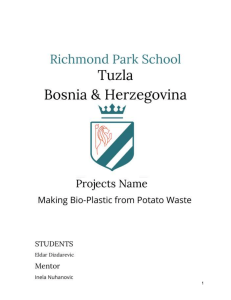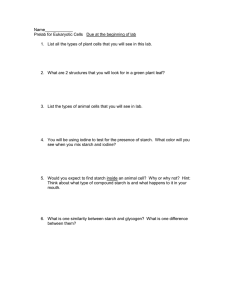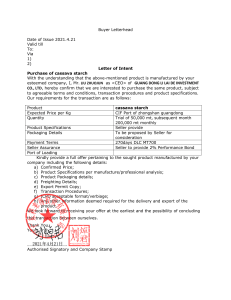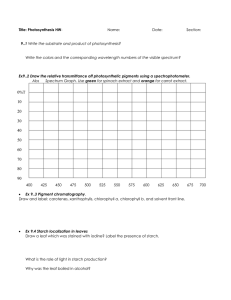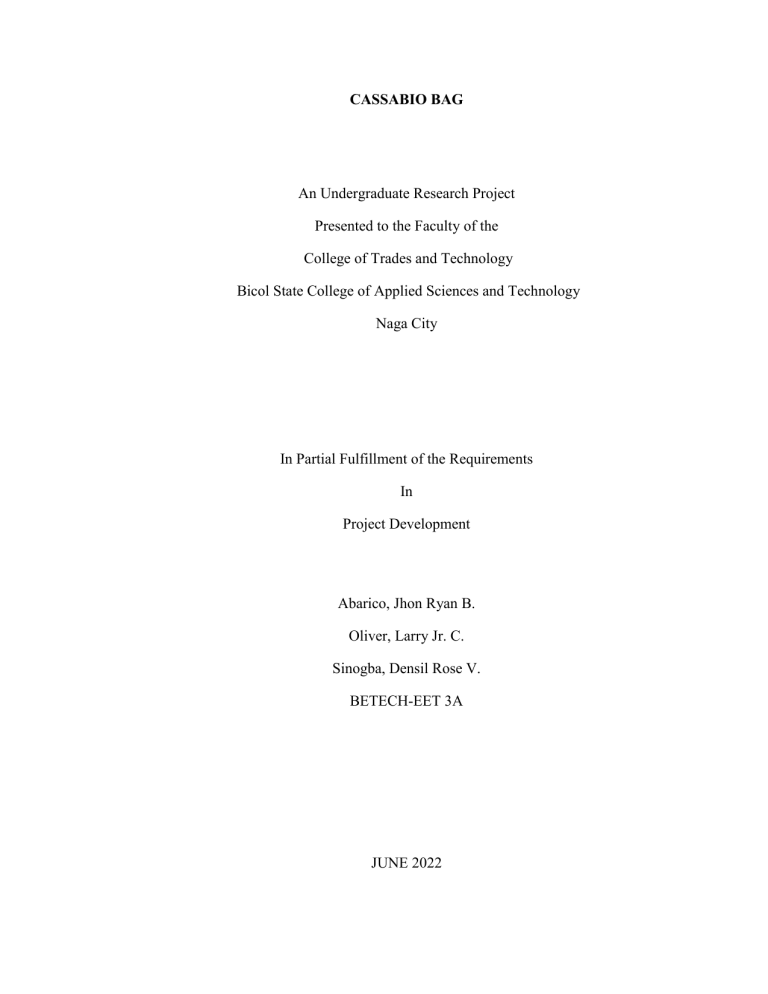
CASSABIO BAG An Undergraduate Research Project Presented to the Faculty of the College of Trades and Technology Bicol State College of Applied Sciences and Technology Naga City In Partial Fulfillment of the Requirements In Project Development Abarico, Jhon Ryan B. Oliver, Larry Jr. C. Sinogba, Densil Rose V. BETECH-EET 3A JUNE 2022 Chapter I INTRODUCTION Bioplastic can be produced entirely or partially from renewable biomass sources like sugar cane and corn as well as microbes like yeast. Under the right circumstances certain bioplastic are biodegradable or even compostable. Bioplastics made from renewable materials can be naturally recycled by biological processes, reducing fossil fuel consumption and preserving the environment. As a result, Bioplastic are long lasting, often biodegradable and biocompatible. Bioplastic are also used in variety of manufacturing applications including plastic bags and food packaging while people using it on daily basis when manufactured are from non renewable materials. These plastics are non biodegradable and in landfills they can take a hundreds of years to decompose, while Bioplastics is made from starch that is environmentally friendly and biodegrades easily. Since land pollution is a major issue in our country, to contribute to environmental preservation and to reduce the production of non-bioplastics, the study will focus on reduction of green house gas emissions and will benefit the people by using local resources and providing more employment opportunities to those who are currently unemployed. Bioplastics are critical in assisting consumer goods firms in presenting their brands in a positive light to make the goods more environmentally friendly to the eyes of people. Philippines ranks as the world’s third biggest plastic polluter in the world with 2.7 million metric tons of plastic waste generated each year after China and Indonesia. Lack of disposal facilities is one of the main problem of plastic pollution and the low rate of recycling activities in the country. 1 To reduce and lessen the plastic consumes every year, there are several ways to make it happen. One of the best examples is using the bioplastics as alternative for the common non bio-degradable plastic that consumer use in the market. This research aims to create “CassaBio Bag”. The objective of said matter is to replace the existing plastics that inorganic and harmful and contribute to the global warming. Researchers are encourage to explore bioplastic research with this option in mind. Statements of the Objectives The objective of the study is to produce a “CassaBio Bag” that aims to: 1. Design and develop an environmental friendly packaging/ bags to reduce the production of non biodegradable material. 2. Steps in developing bioplastic bags with embedded tomato seed using cassava starch. 3. Evaluate the satisfactoriness of the Bioplastic bags with regards to: a) Biodegradability b) Color c) Elasticity d) Texture e) Durability Scope and Delimitation. 2 The study focuses on the production of “CassaBio Bag”. The method use is extraction of starch from the cassava with the addition of glycerin and vinegar. The set-up was composed of three samples were biodegradability, color, elasticity, and texture was assessed. Ruler was used to measure elasticity. The biodegradability set up in, soil, it was assumed that the plastic was thrown away and has different weather condition are beyond the control of the researcher. The production of the bioplastic was conducted in a household kitchen, most of the materials needed in the research are accessible which were bought in any supermarket except for glycerin which bought at new trading, Naga City. The researchers limited this research to the production of “CassaBio Bag” only. The production of the “CassaBio Bag” will assessed by biodegradability, color, elasticity, and texture. There are fifteen (15) respondents, compose of ten (10) randomly selected students, and five (5) faculty teachers from Bicol State College of Applied Sciences and Technology. Definition of Terms 3 The following terms are defined operationally and contextually for the better understanding of the terms use in the study. Biodegradable - Capable of being decomposed by bacteria or other living organisms."Consumers have forced a shift to more biodegradable products" Biomass - plant-based material used as fuel to produce heat or electricity. Examples are wood and wood residues, energy crops, agricultural residues, and waste from industry, farms and household. Bioplastic – A biodegradable materials that come from renewable sources and can be used to reduce the problem of plastic waste that is suffocating the planet and contaminating the environment. Color - the property possessed by an object of producing different sensations on the eye as a result of the way the object reflects or emits light. Compostable - (of organic matter, especially kitchen waste) able to be made into compost. "Compostable waste and recycling will be picked up weekly" Decompose - to break down or be broken down into simpler parts or substances especially by the action of living things (as bacteria and fungi) Elasticity - ability of a deformed material body to return to its original shape and size when the forces causing the deformation are removed Extraction - The action of removing something. Extraction is the process of separating out something from a chemical mixture or compound. Fossil Fuel - are made from decomposing plants and animals. These fuels are found in the Earth's crust and contain carbon and hydrogen, which can be burned for energy. Coal, oil, and natural gas are examples of fossil fuels. 4 Glycerine - Common ingredient in pharmaceutical drugs, including heart medication, suppositories, cough remedies and anesthetics. Greenhouse gas emission - often measured in carbon dioxide (CO2) equivalent. To convert emissions of a gas into CO2 equivalent, its emissions are multiplied by the gas's Global Warming Potential (GWP). The GWP takes into account the fact that many gases are more effective at warming Earth than CO2, per unit mass. Landfills - contain both household and commercial rubbish. Household waste that gets sent to landfill consists of mostly organic waste, for example food, paper, cardboard or wood. Other household rubbish contains plastic or tin packaging. A lot of our individual rubbish is known as Municipal Solid Waste (MSW) Microbes - An organism that can be seen only through a microscope. Microorganisms include bacteria, protozoa, algae, and fungi. Although viruses are not considered living organisms, they are sometimes classified as microorganisms Non- Biodegradable - material can be defined as a kind of substance which cannot be broken down by natural organisms and acts as a source of pollution. Unlike biodegradable wastes, non-biodegradable cannot be easily handled. Non-renewable materials - not renewable a nonrenewable service contract especially: unable to be replaced or replenished once used … most of the natural resources that we exploit for energy and minerals are non-renewable. Preservation - the action of preserving something: to keep safe from injury, harm, or destruction 5 Recycle - to pass again through a series of changes or treatments: such as. a: to process (something, such as liquid body waste, glass, or cans) in order to regain material for human use. Starch - A soft, white, tasteless powder that is insoluble in cold water, alcohol, or other solvents. The basic chemical formula of the starch molecule is (C6H10O5)n. Starch is a polysaccharide comprising glucose monomers joined in α 1,4 linkages. Texture - The visual or tactile surface characteristics and appearance of something. Weather condition - The atmospheric conditions that comprise the state of the atmosphere in terms of temperature and wind and clouds and precipitation. References Retrieved from 6 https://www.eia.gov/energyexplained/biomass/?fbclid=IwAR1O2_FXkMOcliPqJ7MZjYraUsQ3ty5zzlpftSdcvrZhJw7BEEXfTE14tE Retrieved from https://www.britannica.com/science/elasticity-physics Chapter II REVIEW OF RELATED LITERATURE AND STUDIES 7 This chapter presents the related literature and studies from both foreign and local sources. Different materials, such as internet sites, websites, journals, magazines, and articles are gathered to support the further development and innovation of the selected topic. This chapter also includes the conceptual framework. Cassava (manihot esculenta) is one of the most important calories producing crops in the tropics. Beside human use, cassava has attractive uses as a food for the production of living things, starch and alcohol. If cassava growers choose hybridization work, the male sterile genotype should be used. Two types of male infertility are common in cassava. Different Studies Developed on Bioplastic Bioplastics are regarded to be less harmful to the environment since they can be destroyed by living organism, carbon dioxide (Co2), biomass or water. Biodegradable plastics that could be used for food packaging or carrier bags by applying ozone gas to the cassava starch. The ozone (03) gas changes the molecular characteristics of the nonvegetable starch, resulting in a bioplastic that is 30% more durable than those derive from potato, rice and corn (Anas, 2019.) When it comes to biodegradability, bioplastic made from cassava starch is preferable to polyethylene plastic since it decompose in just 45days and does not pollute the environment. Polyethylene plastics tensile strength was superior when it comes to water resistance, research shows that cassava bioplastics dissolves in water while polyethylene does not. In terms of strong acid resistance, the data demonstrate that bioplastic dissolves in HCL whole polyethylene plastic does not. (Hassam E.V Illut 2019) 8 The ecological effects of large amounts of non-biodegradable waste increase exploration to promote new biodegradable materials such as biomass, plants and microorganism. New improvements in bioplastic in the future may increase the effectiveness of creating and lead to the development of new uses and opportunities for bioplastic. Bioplastics are created from renewable materials like starches and vegetable oils, which may be organically recycled by biological processes, reducing the usage of fossil fuels while also safeguarding the environment. Bioplastics are thus long-lasting, mostly biodegradable, and biocompatible. Because plastic is a plant-based product, petroleum usage for its manufacture is predicted to drop by 15–20 percent by 2025. Asia and Europe will hold the highest proportion of the bioplastics market by 2025. Asia will account for 32% of the total market, with Europe accounting for 31% and the United States accounting for 28%. Bioplastics are currently growing at a rate of 10% per year, accounting for 10– 15% of the entire plastics market. By 2020, this figure is expected to increase to 25–30 percent. Syed Ali Ashter (2016) Starch is a readily available, renewable, and inexpensive biopolymer that is commonly utilized in the food sector for packaging. In 2019, starch-based polymers accounted for 21.3 percent of global bioplastic production capacity. European Bioplastics (2019) Polylactic acid (PLA), a plastic replacement derived from fermented plant starch, is used to make corn starch plastic. It's becoming a popular substitute for traditional plastic made from petroleum-based compounds. Liné Cowley(2020) 9 Corn starch plastic is made from Polylactic Acid (PLA), which is a plastic substitute, made from fermented plant starch. It's becoming a popular substitute for traditional plastic made from petroleum-based compounds. Corn starch plastic is a nonpetroleum-based alternative to petroleum-based plastic. Corn plastic, on the other hand, is manufactured from corn starch polymers, a biodegradable and renewable resource. (Cowley, 2020) Conceptual Framework INPUT PROCESS OUTPUT Reference materials: Internet Journals Articles Planning Gathering data Experimentation 10 Figure 1: Conceptual Framework Synthesis of the State-of-the-Art Based on the related literature and studies gathered, bioplastics are less harmful to the environment when it comes to biodegradability. Bioplastics made from cassava is preferable since it decompose in just 45 days and does not pollute the environment. 11 Bioplastics are renewable materials which is originally recycled by biological process which reduces the usage of fossil fuels. The current study is another innovation of bioplastic that can be used as a packaging for food or any materials. The design is suited for the needs of the consumer in order for them to reduce the production of non-biodegradable plastics and help the environment. References Hassan R.V. Illut, Martina Avina P. Mangure, Vinz John P. Ramino; “Biodegradable Plastic from Cassava (Manihotesculenta) Starch”; Ascendens Asia Journal of Multidisciplinary Research Abstracts, Vol. 3 No. 2 (2019): 12 IzathulShafinaSidek, SarifahFauziah Syed Draman, SitiRozaimah Sheikh Abdullah, NornizarAnuar(2019) Current Development On BioplasticsAnd Its Future Prospects: An Introductory Review. I TECH MAG, Vo 1: 03-08. Emily A. Masinde, BernadettaKimata, Joshua O. Ogendo, Richard M. S. Mulwa, Geoffrey Mkamilo, Midatharahally N. Maruthi, Developing dual‐resistant cassava to the two major viral diseases, Crop Science, 10.1002/csc2.20374, 61, 3, (1567-1581), (2021). James H. Cock, David J.Connor, Chapter 19 – Cassava, Editor(s): Victor O. Sadras, Daniel F. Calderini, Crop Physiology Case Histories for Major Crops, Academic Press, 2021, Pages 588-633, ISBN 9780128191941, https://doi.org/10.1016/B978-0-12819194-1.000190.(https://www.sciencedirect.com/science/article/pii/B9780128191941000190) Liné Cowley What is Corn Starch Plastic? September https://ecoworldonline.com/what-is-corn-starch-plastic/ 4, 2020 13 CHAPTER III METHODS AND MATERIALS This chapter presents the methods and materials of the researchers in developing of “CassaBio Bag”. It also includes the planning, the design, the materials and the tool and equipment, are discussed in this chapter. Methods The researchers made us of the current study followed the Research and Development (R&D) method in which specific activities are carried out to innovate a product. Planning, designing, canvassing, and assessment are all parts of this methods. The researcher will use Experimental method to validate the applicability of the “CassaBio Bag” in terms of durability, elasticity, and biodegradability. In order to evaluate the product, the researchers provided respondents with an evaluation sheets. The acceptance of the product was evaluated by the evaluation findings. a) Planning The researchers gathered up all the information needed in developing the “CassaBio Bag” listed all the materials and cost. The study was consisting of seven (8) steps to attain its goal. The succeeding procedure are title proposal, planning, designing, canvassing, construction, evaluation and proposal defense 14 Table 3.1 The time frame of developing the “CassaBio Bag”. January February March April May June Remarks 1 2 3 4 1 2 3 4 1 2 3 4 1 2 3 4 1 2 3 4 1 2 3 4 Title proposal Planning Designing Canvassing Construction Evaluation Proposal defense Planned Actual Planned Actual Planned Actual Planned Actual Planned Actual Planned Actual Planned Actual Table 3.1 Shows the Gantt chart of the work activities which involve the title proposal, planning, designing, canvassing, construction, evaluation, and proposal defense with corresponding time frame. Design of the Study The design of “CassaBio Bag” is like the common plastic bags that use in the market. It is made from cassava starch with added tomato seed. 15 Figure 2: Front View 16 Figure 3: Top View Figure 4: Rear View 17 Figure 5. Side View 18 b) Project Development The study aims to develop a “CassaBio Bag”. Listed here was the process in developing the bioplastic. Peeling ofcassava Refining of cassava Extraction of starch Drying of starch Bioplastic production Embedding tomato seed to the bioplastic Drying of bioplastic Testing and evaluation Figure 6: Block Diagram of the “CassaBio Bag” 19 c) Trials and Revisions At Naga City's Peoples Mall, fifteen (15) kilos of fresh cassava were purchased. These were completely cleaned with tap water. One (1) kilo of uncooked flesh and one (1) kilo of cooked flesh were used. Uncooked peelings accounted for five (5) kilos, while cooked peelings accounted for five (5) kilos. At New TH Trading, one (1) liter of glycerin was purchased. For around fifteen (15) minutes, half of the cassava was cooked. After that, the cassava was peeled away. Separate bowls of water were used to soak the raw and cooked cassava peelings. The cooked and uncooked cassava flesh was grated in separate bowls with a grater and then soaked in separate bowls of water. The starch was extracted from the uncooked and cooked flesh and peelings by straining them into a dish. To allow the starch to settle, the filtered liquid was allowed for around ten (10) minutes. The bottom of the container created a white coating, suggesting that the starch had settled. After that, the liquid was decanted into a new container, leaving the starch behind. The container with the starch was dried overnight until it turns to powder. A non-stick pan was used to cook the cassava. The mixture was constantly mixed until it became sticky and bubbles began to appear. Following that, it was poured into the tray. Dried tomato seeds will be attached to the bio plastic before it took around three (3) days to dry. 20 d) Validation and Evaluation The researchers looked at biodegradability, color, elasticity, and texture. Each was divided into nine (9) equal pieces, six (6) of which were used for the biodegradability and elasticity tests. Sensory evaluation was used to assess color and texture. In the biodegradability test, each of the four (4) samples will placed in the soil and exposed to the air. Each sample consisted of six (6) bioplastics of equal size, three of which were placed in the soil and three of which were exposed to the air. For a month, data was collected once a week. Sensory evaluation was used to assess them.When the bioplastic is stressed, the length of elongation in centimeters is measured before it breaks with a ruler for elasticity. Statistical Treatment of Data The rating for the evaluation will be determined through computed-weighted mean of the individual scores of the raters. The formula of the weighted mean is: 𝑾𝒆𝒊𝒈𝒉𝒕𝒆𝒅 𝒎𝒆𝒂𝒏 = ∑𝒇(𝒙) 𝒏 Where: ∑ is the summation of x is the number of scores n is the total number of samples 21 Materials Cost of Supplies and Materials Table 2. Cost of materials of the “CassaBio Bag”. Quantity Unit Description 15 Kilos Cassava 1 Litre Glycerine 1 Litre Vinegar 1 Kilo Tomato 5 Sachet Food color (optional) 1 pc Knife /peeler 1 pc Grater 3 pcs Container 1 pc Strainer 3 pcs Measuring spoon 1 pc Non-stick pan 2 pcs Mixing bowl 3 pcs Food tray 1 pc Ruler 1 pc Spatula 1 pc Blender 1 pc Stove Unit Price 30 158 50 30 5 20 25 30 15 30 339 119 40 20 86 649 1500 Total Amount: Total Price 450 158 50 30 5 20 25 30 15 30 339 238 120 20 86 649 1500 3765 Php 22 Tools and Equipments Table 3. The Tools and Equipment of the “CassaBio Bag” and its uses Name of tools Pictures Knife /peeler Function To peel the cassava Grater To grate the cassava Container To contain the cassava mixture 23 Strainer Use for separating the cassava starch from water Measuring spoon To measure the cassava starch and water Non-stick pan Use for making the mixture Mixing bowl To contain the cassava mixture 24 Food tray To contain the cassava mixture Ruler Used to measure the elasticity of disposable biodegradable plastic Spatula Used to scrape the cassava mixture from the container 25 Stove Used for boiling the cassava Blender Used to refine the cassava starch 26 References Retrieved from https://ph-test-11.slatic.net/p/3bc56e21c494919018fc342c59bade79.jpg Retrieved from https://lzd-img- global.slatic.net/live/ph/p/10ba7639752a65ffc0724aa21885b580.jpg_720x720q80.j pg_.webp Retrieved from https://s3-ap-southeast-2.amazonaws.com/wc-prod- pim/JPEG_1000x1000/SM388700_studymate_stainless_steel_ruler_15cm.jpg Retrieved from https://www.thespruceeats.com/thmb/DcBi7XfU4ruwMW8p5mzdjh06hkM=/1500x 1500/smart/filters:no_upscale()/rubbermaid_high_heat_spatula45a00489c0fd43eda6994d14a153bd6a.jpg Retrieved from https://d1rlzxa98cyc61.cloudfront.net/catalog/product/cache/1801c418208f9607a37 1e61f8d9184d9/1/4/145212_2020.jpg Retrieved from https://d1rlzxa98cyc61.cloudfront.net/catalog/product/cache/1801c418208f9607a37 1e61f8d9184d9/1/6/163927_1.jpg Retrieved from https://lzd-img- global.slatic.net/live/ph/p/10ba7639752a65ffc0724aa21885b580.jpg_720x720q80 .jpg_.webp 27 Retrieved from https://assets.epicurious.com/photos/5e67b358df5de60008b1d3f7/1:1/w_1548,h_ 1548,c_limit/winco-strainer.jpg https://www.thespruceeats.com/thmb/A7iqSNoWGAeYAtfMXNl9T57zrA8=/fitin/1500x1066/filters:no_upscale():max_bytes(150000):strip_icc()/UTasteStainlessSteelMeasuringSpoons-4e0707abf19f46d69dea53a879d28916.jpg Retrieved from https://static.scientificamerican.com/sciam/cache/file/C8A442EF-B8ED4CE3-A761B2D0743C1D22_source.jpg?w=590&h=800&18D8F99D-210E495A-AF565FB57C1C3A7E 28
